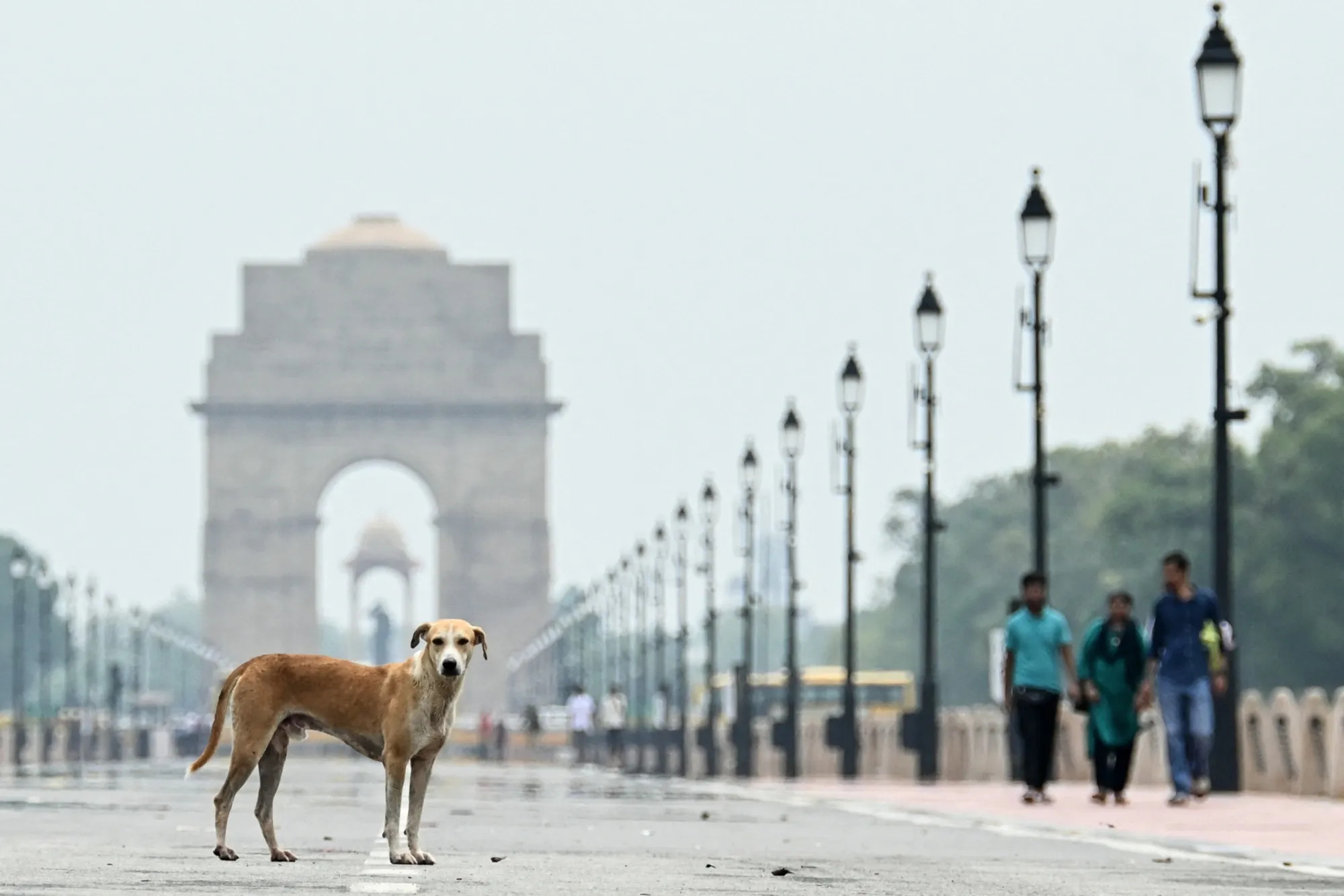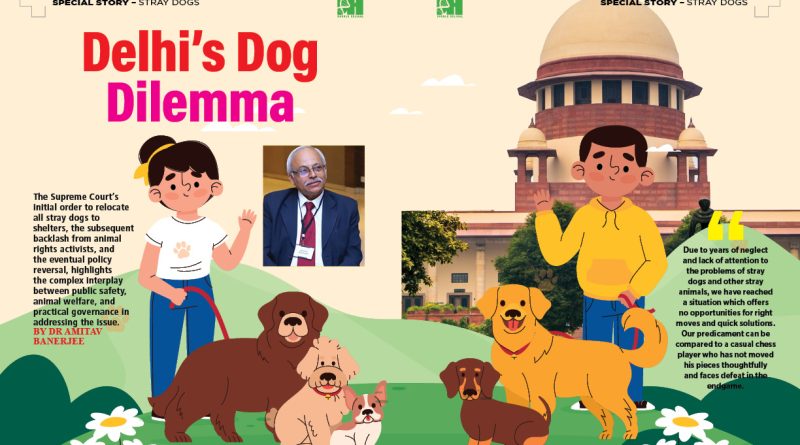Delhi’s Dog Dilemma

The Supreme Court’s initial order to relocate all stray dogs to shelters, the subsequent backlash from animal rights activists, and the eventual policy reversal, highlights the complex interplay between public safety, animal welfare, and practical governance in addressing the issue.
By Dr Amitav Banerjee
In the game of chess, zugswang is a position where players are forced to make a move that worsens their position and would prefer to skip their turn but cannot. The word has its origin in the German language, meaning “compulsion to move” or “coercion to move.”
The Supreme Court (SC) found itself in this unenviable position recently when it took a suo motu call on the vexing issue of stray dogs in Delhi NCR. With “National Dog Day,” which is observed on August 26 every year, imminent, the SC, on August 11, 2025, ordered all stray dogs to be removed from the streets and housed in dedicated shelters under the arrangement of the concerned authorities within eight weeks. Dogs should be thankful for small mercies. During the pandemic, humans were locked down with four hours’ notice! Directions were given by the SC that the municipal bodies should create adequate shelters within this period and ensure all public spaces are free of stray dogs. It also emphasised that once in a shelter, no dog should be released back onto the streets. The authorities were instructed to start picking up stray dogs from all public spaces with immediate effect.

The Supreme Court Judgment is Short-sighted
One may ask why only Delhi-NCR—why not the entire country, since the stray dog menace is present in all states. Ahmedabad, for instance, witnessed a high-profile tragic death a couple of years ago as a result of stray dogs. Parag Desai, the Executive Director of the “Wagh Bakri Chai” Group, died on October 22, 2023, after a dog attack outside his residence. While trying to escape a pack of stray dogs during a walk, he fell, sustained a severe brain haemorrhage, and later succumbed to his injuries in the hospital at the age of 49. The incident sparked renewed public discussion and debate in India regarding the stray dog menace.
Animal Rights Activists Resist the SC Order
Animal and dog lovers expressed anguish over the SC directives. They accused the court of inciting public authorities in Delhi to “ignore” the existing rules, as well as overlooking ground realities. There are over one million stray dogs in Delhi and hardly any dog shelters.
Moreover, overcrowding of these animals in shelters has the potential to trigger animal-borne diseases or zoonoses like leptospirosis, viral infections, and even the deadly rabies. And removing the sterilised and vaccinated stray dogs from their localities can precipitate the “vacuum effect” with unvaccinated, more aggressive dogs moving in.
Former Union Minister and animal rights advocate Maneka Gandhi called the plan impracticable. She estimated that building the proper infrastructure and shelters for the stray dogs would require a budget of `15,000 crores. She also pointed out that removing stray dogs will not only attract stray dogs from neighbouring regions to fill up the vacuum but also attract other animals like monkeys and rats. She gave the example of Paris in the 1880s. When the French city removed stray dogs and cats, the place was overrun with rats. She called dogs “rodent control animals.” Instead of relocation, Maneka Gandhi recommended strict enforcement of existing measures such as sterilization, anti-rabies and distemper vaccinations, and close monitoring of Animal Birth Control Centres (ABCs).
Supreme Court Makes a U-Turn
In response to these concerns, the SC made a U-turn after deliberations on the issue, with the court emphasising the implementation of the existing Animal Birth Control Rules 2023, which prohibit relocation of stray dogs. The revised order excluded dogs with rabies or aggressive behaviour and also banned the feeding of stray dogs in public spaces, directing authorities to make provisions for earmarked feeding centres in every locality. On August 22, 2025, the SC reversed its earlier order and mandated that stray dogs which were captured should be returned to their original locations instead of being sent to shelters, after sterilization and anti-rabies vaccination. The SC also called for a nationwide policy on the stray dogs issue.
A Move Forward Only to Take It Back—As Any Move Worsens Our Stand
As things stand, with these U-turns, we are going around in circles. Due to years of neglect and lack of attention to the problems of stray dogs and other animals, we have reached a situation which offers no opportunities for right moves and quick solutions. Our predicament can be compared to a casual chess player who has not moved his pieces thoughtfully and faces defeat in the endgame.
Just as building shelters for millions of dogs will incur huge costs and will take years, the ABC program, if it is to be carried out in letter and spirit, would require a large number of veterinary surgeons, operating rooms, dog catchers, other ancillary staff, and vehicles. Setting up locality-wise dog feeding centres would require additional human resources and money.
Do We Have the Correct Figures for Rabies—the Most Dreaded and Fatal Condition Due to Dog Bites?
The WHO website states that there are 18,000 to 20,000 deaths from rabies annually in India. These are estimates. But according to Indian Government figures, in 2023, 121 people died of rabies and 2,223 presumptive cases were reported. Though the number of presumptive cases of human rabies has come down from 4,885 in 2022 to 1,079 in 2024, the number of rabies deaths has increased to 180 in 2024 from 22 in 2022. These figures were given by the Animal Husbandry Ministry in the Lok Sabha on August 5, 2025.
The wide disparities in the WHO figures of 18,000 to 20,000 rabies deaths annually, and the Government of India’s figures ranging from 22 to 180 confirmed deaths and 1,079 to 4,885 presumptive cases, are very perplexing. If such large disparities exist for a fatal and important condition like rabies, one cannot be certain of other disease estimates from the WHO either.
The Way Forward
We should shrug off the laissez-faire approach over the years which has landed us in this stalemate and make up for lost time. The cost and resources for either option—whether dog shelters or ABC protocols with neighbourhood feeding centres—are going to be huge but are unavoidable.
We also need to develop a robust surveillance system for rabies cases as well as other conditions, and our own estimates. We should not depend on WHO figures which appear to be gross overestimates. There should be better coordination between our Ministry of Health and the WHO to sort out such discrepancies.
(The author is a renowned epidemiologist and currently Professor Emeritus at Dr DY Patil Medical College in Pune, India. He served in the armed forces for over two decades and ranked in Stanford University’s list of the world’s top 2% scientists two years consecutively in 2023 & 2024. He is also the Founder Chairperson of Universal Health Organization, a registered watchdog on public health issues)

